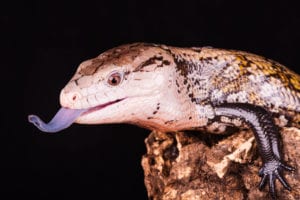Blue Tongue skinks are one of the more popular skink species due to their larger size and characterful nature. They still have the characteristic skink short legs, which does deter some keepers (too snake-like in appearance), but they are much chunkier, with a very pronounced head – much more appealing looking to many keepers. As the name suggests they have a blue tongue which is thought to be a deterrent to predators. There are several species, subspecies and variants that naturally occur throughout Australia and New Guinea and various Indonesian islands.
They are a relatively easy species of lizard to keep, but they do require reasonably large vivaria as adults. They do not spend a great deal of time climbing, so the vivarium needs to be long rather  than tall, we would suggest a bare minimum of a four feet long vivarium for one adult, preferably longer. They are a basking diurnal species, which means they bask in the suns rays and are active during daylight hours. For this reason a basking source must be provided – debate is strong on the topic but most keepers use an incandescent bulb or ceramic heat. Our own personal choice would be a ceramic heater so we had total control independently for heat and light. Light would be provided, in our view by a T5 12-14% UVB fluorescent tube for around twelve hours each day (unless a variable photoperiod is required, say for breeding purposes). Provide a water bowl, hides and climbing décor that provides stimulation and interest for the skink – we would provide hides that some are dry and some are moist underneath to give a choice. Substrate can vary depending on the locality of Blue Tongue you are keeping, whether it be from an arid region or a tropical region. They are greedy feeders and will take all commercially available livefood, and most will take the various artificial foods specifically aimed at species like this – however we find the favourite food of Blue tongues to be snails.
than tall, we would suggest a bare minimum of a four feet long vivarium for one adult, preferably longer. They are a basking diurnal species, which means they bask in the suns rays and are active during daylight hours. For this reason a basking source must be provided – debate is strong on the topic but most keepers use an incandescent bulb or ceramic heat. Our own personal choice would be a ceramic heater so we had total control independently for heat and light. Light would be provided, in our view by a T5 12-14% UVB fluorescent tube for around twelve hours each day (unless a variable photoperiod is required, say for breeding purposes). Provide a water bowl, hides and climbing décor that provides stimulation and interest for the skink – we would provide hides that some are dry and some are moist underneath to give a choice. Substrate can vary depending on the locality of Blue Tongue you are keeping, whether it be from an arid region or a tropical region. They are greedy feeders and will take all commercially available livefood, and most will take the various artificial foods specifically aimed at species like this – however we find the favourite food of Blue tongues to be snails.
Blue Tongue Skinks are a great favourite of ours at Coast to Coast Exotics, we think they make a great alternative choice to the more mainstream pet species such as Bearded Dragons.
